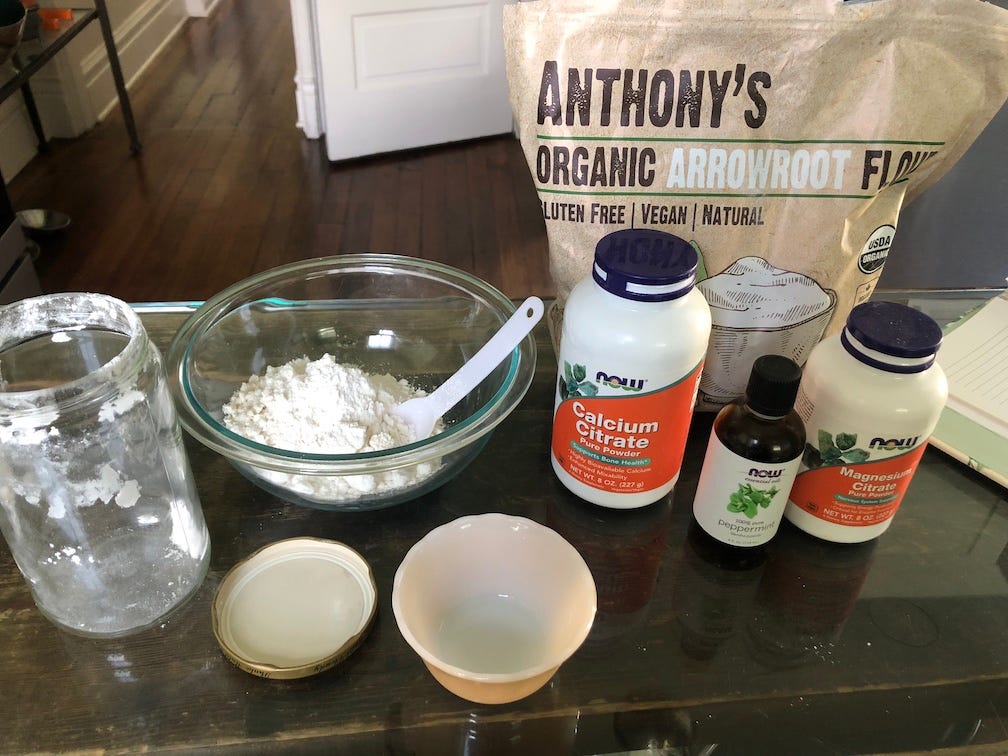Weed pairing: Homemade toothpaste and herbal gum wash
We team up with Weedom to fight tooth decay!
By Lisa Brunette and Weedom
Today I’ve asked weedom to collaborate with me on a “weed pairing” of my homemade toothpaste with weedom’s recipe for herbal gum wash. If you’re not familiar with weedom , you should definitely check out that Substack, as it’s a terrific resource, with excellent analyses of the so-called “weeds” growing in our yards, such as the powerhouse medicinal, yarrow, and the wonderful spring tonic, cleavers.
So first, the toothpaste. I promised I’d share my recipe when I wrote about my high-school science teacher back in April.
His version contained just two ingredients: hydrogen peroxide and baking soda. But we can make something that’s a bit nicer than that. I’ve adapted this recipe from Rain Country, honing in on the perfect ratio of baking soda to arrowroot and just the right amount of essential oil, and I use it twice daily. Commercial toothpaste is a real problem, with its artificial flavors and colors, plus other additives to make it gel, but you can whip up a batch of toothpaste yourself that actually supports your health and costs far less instead. Since I switched to homemade four years ago, I’ve had a 100 percent clean bill of health from my dentist every time1, and my teeth are whiter, too.
Homemade toothpaste
Ingredients
1 cup Baking soda
1 cup Arrowroot powder
1/4 cup Magnesium citrate—Note, the beauty of these powdered minerals is that they contain no additives, as those are usually required to make the capsules and then to oil the capsules for faster shuttling through machines.
1/4 cups Calcium citrate
(Optional) A few drops of an essential oil or powdered herb per your taste (mint, lemon, clove, etc.). Or even better: dried, powdered herbs such as mint, lavender, and so on.
Place all of the ingredients in a large bowl and whisk them together.
Transfer the mixed powder to a lidded jar using a wide funnel.
I like to keep a tiny dessert dish or ramekin full of the powder in the medicine cabinet. Wet your toothbrush and drag it through the powder to use on your teeth.
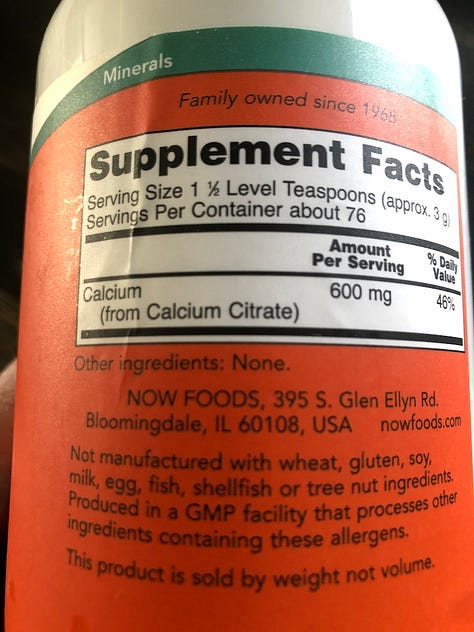
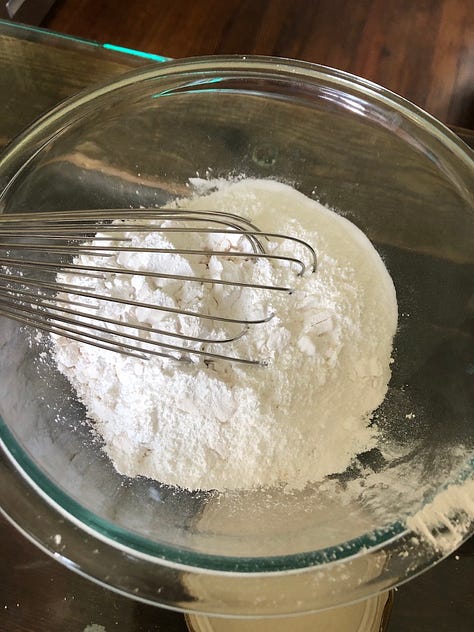
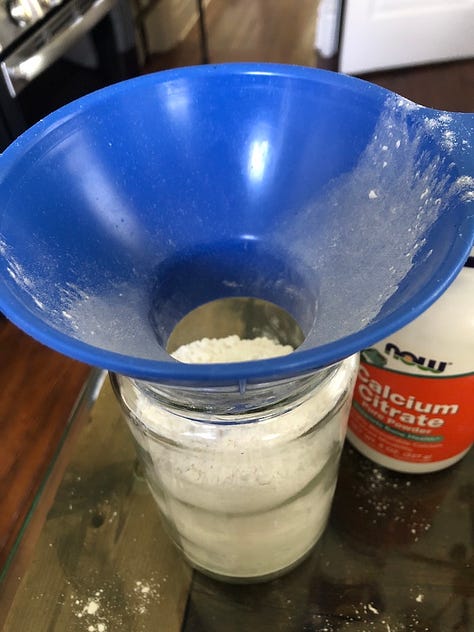
Here’s a printable PDF:
As background for the herbal gum wash:
And here’s weedom to walk you through how to make the wash, or as they call it, “Waterpik juice.”
Spraying around the gum line and between teeth with the “Waterpik” or other water flosser is a way to clean food chunks from around gums and prevent inflammation and infection. There are some commercial water flosser solutions on the market to use in place of water, but you can make your own with some well-known anti-infective and healing herbs. We’ve been able to pull the components for our recipe from what’s growing in the yard and gardens this summer.
Herbal gum wash
Ingredients
Equal parts by weight of the following herbs, dried:
Calendula, whole flowers—anti infective, anti-inflammatory herb
Peppermint leaf—for flavor, but also anti-infective
Plantain leaf—demulcent, anti-infective, especially when fresh
Comfrey leaf—supports tissue regeneration and healing. This can be left out during times when slower healing is desired, such as after tooth extractions, to avoid dry socket.
Marshmallow root—demulcent and soothing to mucous membranes and tissues (Leaf is also useful, but it will occupy more volume. The related mallow plant and hollyhock flowers could be used instead)
Note: In season, we also make this with fresh herbs, using 3 times the weight of the chopped product.
About 4 grams of each dried component in a liter of water at tea-making temperature will produce a strong solution. We find that shot glasses measure this amount adequately. If you don’t have scales, fill up about 3 rounded tablespoons of each component, except when using marshmallow root; only 1 1/2 tablespoons are needed.
Hot, but not boiling water is good enough to extract the components. This will cool quickly, and it won’t make a mess of the mucilaginous components of marshmallow.
We pour the herbs into the hot water, stir it, put a lid on the mix, and let it infuse for 2 hours or so.
You can store this infusion in the refrigerator and expect to use it up within a week with daily or twice-daily use. We allow a portion to warm a bit before using it in the Waterpik, to avoid irritating sensitive teeth. It’s a palatable, clear solution that does not adversely affect the water flosser. We’ve seen some stray spots on the bathroom wall, though!
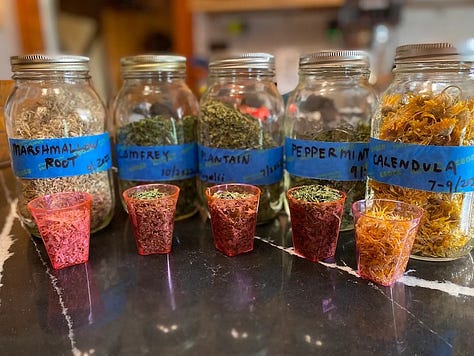
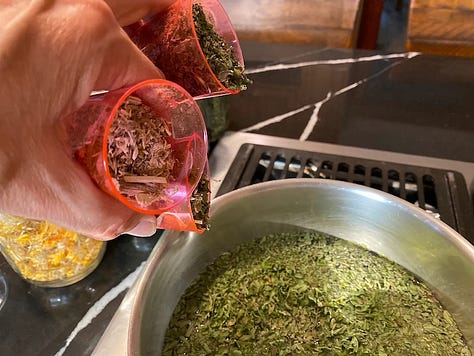
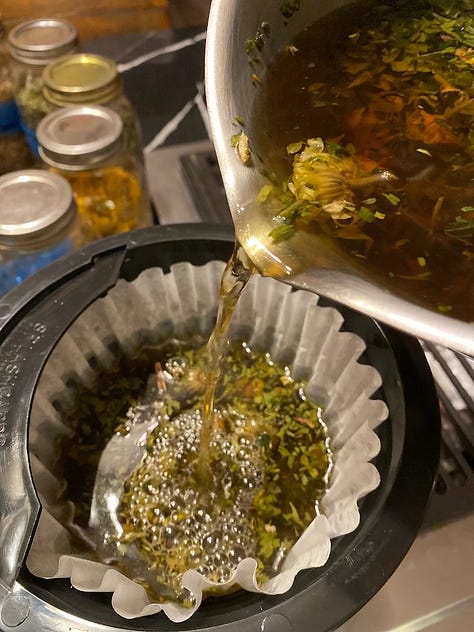
If you frequently make herbal infusions, try to get a spare coffee-maker filter holder or cold-brew coffee filter you can dedicate to the job. We filter the infusion directly into a quart-sized mason jar, and squeeze the contents of the coffee filter to obtain as much juice as possible. The filtering process prevents any herbal chunks from getting into the water flosser or from being sprayed into your gum line. A colander and filter will work, too, but might take longer.
At weedom, we filter a lot of infusions (for medicine and soap-making), and notice that a cold solution takes much longer to filter. Rewarming a cold infusion just a little bit before filtering will save you lots of time.
Check your yards and gardens for good components of “Waterpik juice.” There is some redundancy in the functions of the herbs that we have chosen for our mixture. Perhaps you can formulate your own. Other plants can be substituted to provide similar supportive benefits to gums and tissues of the mouth.
Please see the Brunette Gardens Notices & Policies page for our medical disclaimer and other policies. This page contains affiliate links; we might earn a small commission at no extra cost to you if you purchase via the links.




